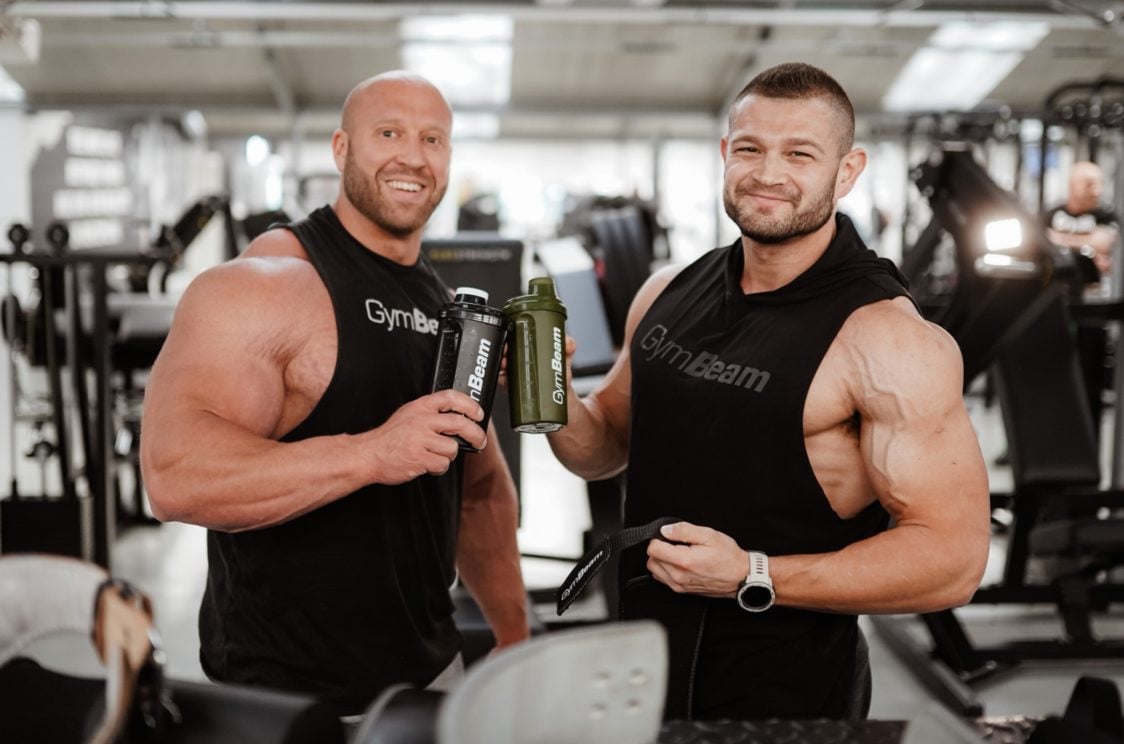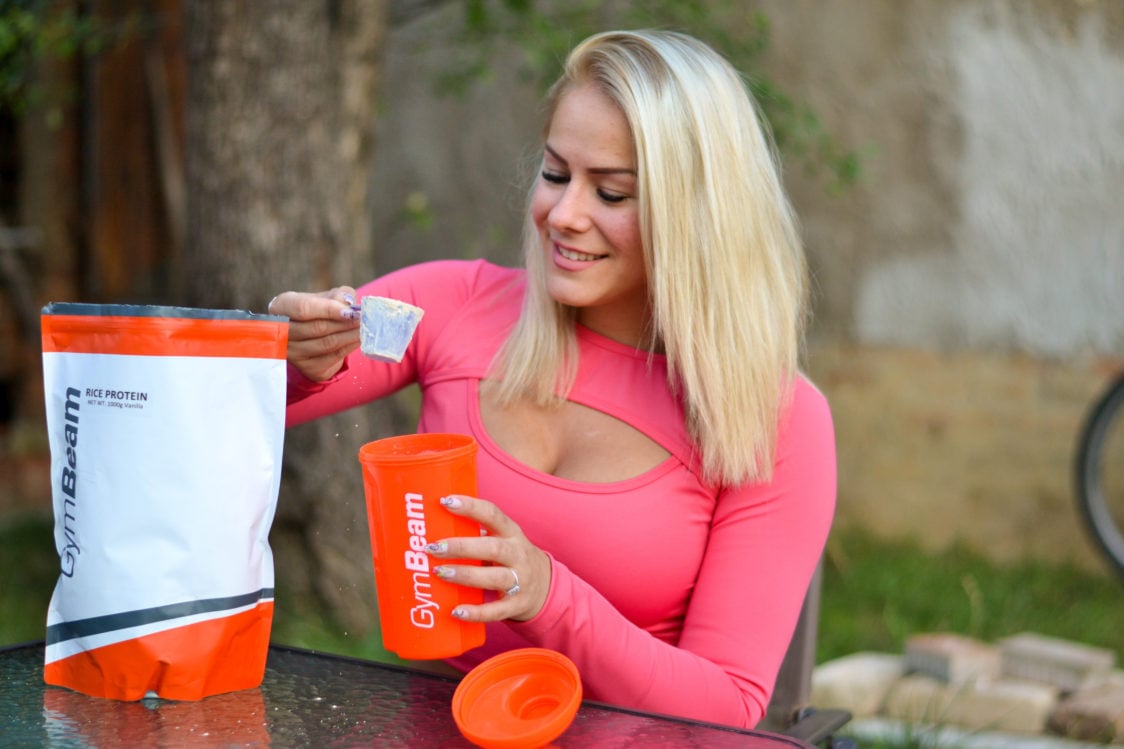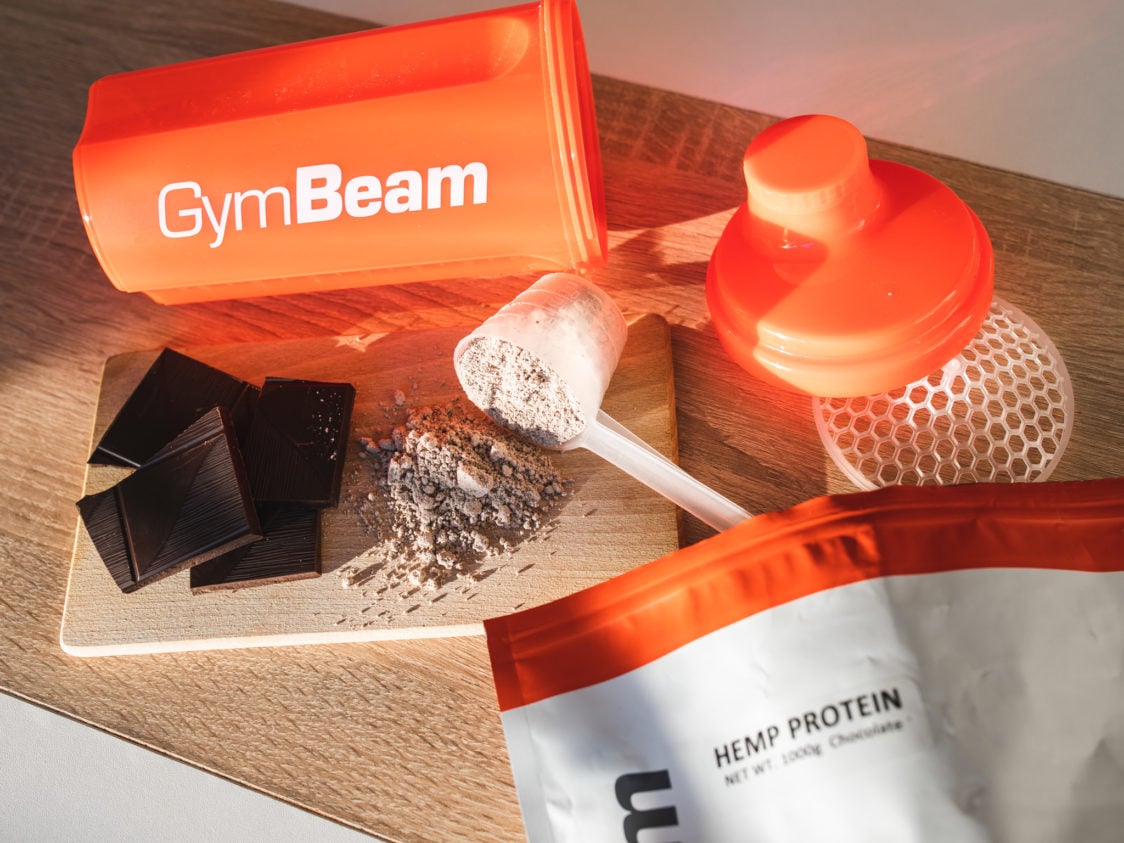Table of Contents
Proteins are deservedly among the most popular dietary supplements worldwide. They help you to lose weight, gain muscle, support regeneration and immunity. The most common form of whey protein is made from milk. But what to do if you prefer a plant-based diet? In that case, you need to choose a quality protein from outside the animal kingdom. In today’s article we will advise you how to do it. At the same time, we’ll discuss what protein powders are good for and how to use them to get the most out of them.
In our article you will read about the following protein powders:
How do plant and animal protein powders differ?
Perhaps not surprisingly, these protein powders differ mainly in their ingredients profile. Plant products come from natural sources and contain no animal ingredients. They are therefore especially popular among vegans. Compared to animal proteins, however, they have a lower quality amino acid spectrum. As a rule, they contain lower amounts of BCAAs, led by leucine, which has the highest anabolic potential of all essential amino acids. Plant proteins are also less absorbable than animal proteins. It is therefore necessary to use higher amounts of protein, supplement free amino acids in other ways or consume probiotics at the same time to increase absorption.
But just because plant proteins have their drawbacks doesn’t mean you shouldn’t use them. Vegan protein is such a great way to give your body a protein boost. You need to know which ones are best, how to combine them properly and how to improve their usability. We’ll take a closer look at all these questions in this article.
How are plant proteins beneficial?
Plant-based protein powder is a concentrated source of protein that is not derived from the animal kingdom. It is produced from plant sources such as various legumes, seeds or cereals. For example, proteins from peas, soy, rice, hemp or pumpkin seeds. Depending on the source, protein powders differ in their ingredients profile or quality, especially with regard to their specific amino acid spectrum. These are thus proteins that are ideal especially for vegans or people who avoid animal products in their diet for whatever reason.
Although there are differences between the various proteins, they all boast a high protein content. This gives them a range of benefits that you’ll appreciate for weight loss, muscle gain and health promotion.
The benefits of plant proteins:
- Speed up your metabolism: this point is related to the thermic effect of protein. This is because you consume approximately 30% of their energy value when processing it. This is the highest of all macronutrients. Thus, thanks to protein intake, you burn calories practically for free. [1-3]
- Help with weight loss and maintenance: protein helps with muscle maintenance. It uses more energy than fat, even at rest. If you have more muscle, you naturally have a higher expenditure. [4-6]
- Promote muscle growth and maintenance: the amino acids that make up protein are the building blocks of muscle tissue. In addition to being important for building muscle mass, they also help with muscle maintenance. This is especially important in a diet with reduced energy intake. [7, 8]
- Help with regeneration: protein helps with muscle repair damaged by training. They can also be useful in the regeneration of tissue that has been damaged, for example by injury. [9, 10]
- Promote your immunity: protein is indispensable for the production of immune cells and antibodies. [11, 12]
- Reduce hunger and cravings: of all the macronutrients, protein has the highest satiating effect. If you eat enough of them with every meal, the chances of fighting off hunger and cravings increase. [13-16]
- Promote bone health: in addition to maintaining healthy bones, protein can help prevent fractures or the development of osteoporosis. [17-20]
If you want to find out more about how protein can help with weight loss, you shouldn’t miss our article How to Select the Best Protein for Weight Loss?
You can read more about its other abilities in our article How Protein Changes a Woman’s Body and Helps To Lose Weight.

You might be interested in these products:
How much protein should you consume?
Athletes and active people are usually advised to stick to a range of 1.4-2 g of protein per kilogram of body weight (BW). For a 70 kg athletic person, this is something between 98-140 g. [21, 22]
If you want more accurate recommendations based on your sporting activity and lifestyle, then our energy intake and macronutrient calculator will help you with those figures.
How do we classify plant proteins?
Plant-based or vegan proteins can be categorised in several ways based on different criteria. However, the most common distinctions are based on their source and processing.
- The raw materials from which the plant protein is produced are crucial for the classification according to the source of the protein. These are usually legumes, seeds or cereals.
- In addition, for plant-based protein powders you will most often encounter two types, which are called protein concentrate and isolate. However, protein hydrolysate is also becoming increasingly common. The difference between the two is in the production processes that have been used. Compared to isolate, the protein concentrate has undergone fewer filtration processes and usually contains less protein. The isolate has a so-called purer ingredients profile. It has undergone a higher number of filtration processes and typically contains more protein. Another form is hydrolysate, which is again the most concentrated. This makes it the most beneficial for the body.

1. Soy protein
Soy protein is one of the most popular plant-based alternatives, especially among vegetarians and vegans. In addition to its relatively low price, its advantage is a decent proportion of protein, which also has the highest quality spectrum of EAAs (essential amino acids that our body cannot produce on its own). It is the most similar to high quality whey protein. That’s why it is the first choice for vegan athletes who want to bulk up their muscles and replenish quality protein.
In addition to protein, however, bioactive substances in the form of isoflavones can also be found in the ingredients. These are bioflavonoids that can interact with various hormones such as oestrogen. In reasonable amounts, their influence is primarily positive, as they help to maintain bone quality and mineralisation. Bone loss is then associated, for example, with osteoporosis. In some studies that worked with larger amounts of isoflavones, several men showed a reduction in testosterone levels in their blood. However, if you use 1–2 scoops of this protein per day, you don’t have to worry about a negative effect on your testosterone levels. [23-27]

How is soy protein produced?
Soybeans are made into white flakes by defatting, dehulling, washing in water and alcohol and other processes. These are ground into flour or meal, which is approximately 50-54% protein. The extraction process then removes the aromatic substances and sugars to produce a protein concentrate. However, the mixture can still be further processed. Subsequent processes, which include, for example, removal of the fibre and further centrifugation or drying, would produce a soy isolate which has a higher protein content. [40, 41]
How much protein does soy protein powder contain?
Soy concentrates contain about 70% protein as a rule. If further processed, soy isolate can be more than 90% protein. However, it is more often around 85%.
What are the benefits of soy protein?
- It is one of the most budget-friendly protein powders, which means it is well priced.
- It can contain a very high protein content.
- It has a favourable amino acid spectrum, most similar to high quality whey protein.
- Thanks to isoflavones, soy protein can have a positive effect on bone quality in menopausal women.
- Among plant proteins, it is one of the better tasting.
- It is ideal for making thick porridge.
What are the disadvantages of soy protein?
- It may have a higher sugar content.
- It is often considered as a lower quality source of protein.
- It dissolves less easily.
- Higher antinutrient content. [28]
2. Rice protein
Although you know rice primarily as a source of carbohydrates, surprisingly it is also used to make protein. However, it is not equal in quality to, for example, whey protein. Its disadvantage is that it has lower levels of essential amino acids such as lysine. This is the so-called limiting amino acid in rice protein. However, you can compensate for this deficiency by significantly increasing the serving or by combining the protein with another source, such as soy or legume protein. In fact, there is sufficient lysine in these varieties. This will create a protein that has a better final amino acid profile. [29-32]
How is rice protein produced?
Rice protein is made from white or brown rice. The harvested grains are cleaned and milled. Specific enzymes are used to separate the protein from its natural starch. This provides the basis for the production of the specific rice protein. [29-32]
How much protein does rice protein powder contain?
The protein content varies from product to product. As a rule, however, it varies between 50-78%. Similarly, you can also find different proportions of carbohydrates and fat in these protein powders. [29-32]
What are the advantages of rice protein?
- It is suitable for the preparation of thicker porridge.
- It is affordable.
- It can have a relatively high protein content.
What are the disadvantages of rice protein?
- It needs to be combined with legume or soy protein to improve the resulting amino acid profile of the protein powder.
- Compared to whey protein, it is more difficult to dissolve.
- The taste may not be to everyone’s liking.

3. Hemp protein
Hemp protein is becoming increasingly popular among people. There is no need to be afraid of it. It does not contain any THC or other psychoactive compounds found in marijuana. Hemp seeds have been in our diet for thousands of years. But if you don’t feel comfortable consuming it in seed form, then hemp powder might just win you over.
Unfortunately, hemp protein powder does not have an ideal amino acid spectrum. You won’t find too much lysine or leucine in it. There is approximately half as much of the latter in hemp protein compared to whey protein powder. To counteract this deficiency, it is ideal to combine it with pea protein, for example. [33-35]
How is hemp protein powder produced?
Hemp protein is produced from purified hemp seeds. These are gradually pressed and milled until they become a fine flour. This is then sieved to separate the fibre-rich parts and the fine powder. An air classifier is most often used for this purpose. This minimises clogging of the holes in the sieve by fatty bits. The fine powder that is separated by sieving serves as the basis for the hemp protein. [42]
How much protein does hemp protein powder contain?
Typically, hemp protein powders has around 50% protein content.
What are the advantages of hemp protein?
- Ideal for preparing thick and hearty porridge.
What are the disadvantages of hemp protein?
- A relatively low protein content.
- Some people may not like the taste of it.
- It’s relatively low in leucine and lysine.
- It has a higher fibre content, which is not ideal if you are taking the protein after a training session and want to start the recovery process immediately.
- It’s higher in fat and carbohydrates, which isn’t ideal if you’re focused on maximising your protein intake.
- It is one of the more expensive plant-based protein powder`s.

4. Pea protein
In the plant kingdom, pea protein can be considered a good choice for strength athletes who want to build muscle. It boasts a high content of leucine, which has the highest anabolic potential of all the amino acids and thus aids muscle growth. However, it also contains less methionine and cysteine, which you can balance by combining it with rice protein.
How is pea protein produced?
Pea protein is made from yellow and green peas. After harvesting, the peas need to have their skins removed first. Only then can they be ground into flour, which is rich in protein, starch and fibre. The flour then goes through a filtration process during which the starch and fibre are removed. This produces a more concentrated blend containing a high concentration of protein. This is further dried and then forms the basis for pea protein. [36]
How much protein does pea protein powder contain?
Pea protein powder is the most common, with between 70-80% protein.
What are the advantages of pea protein?
- A higher leucine content.
- Thanks to its favourable content of essential amino acids, it is one of the proteins that are suitable for building muscle mass.
- It is easily digested. [37]
What are the disadvantages of pea protein?
- It dissolves poorly.
- As a rule, it does not taste the best.
- It has a sandy consistency that can be unpleasant.
- Lower methionine content, which can be compared to a combination of a cereal protein source (e.g. rice).
- It has a higher fibre content, which slows down the absorption of protein.
5. Multi-ingredient plant protein
Multi-ingredient proteins are one of the best options when choosing a plant-based protein powder. It combines several sources of protein and thus can compensate for deficiencies in the form of limiting amino acids. This results in a protein powder with a more favourable amino acid spectrum, which is closest in quality to whey protein.
The foundation is therefore often a combination of protein from cereals and legumes. In the case of plant-based multi-ingredient proteins, you will often see, for example, a combination of pea and rice. Cereal proteins have a lower lysine content, whereas legume proteins are poorer in methionine and cysteine. Pea and rice help compensate for each other’s deficiencies, and you get a high-quality plant protein with a favourable amino acid spectrum. However, it certainly doesn’t hurt to include other protein sources such as pumpkin or hemp seed or soy.

Other types of plant-based protein powders
- Pumpkin protein
- Quinoa protein
- Almond protein
- Chia seeds protein
- Sesame protein
- Sunflower protein
- Potato protein
- Protein from the air: You’re probably wondering what protein from the air is doing here? There are currently experiments to produce this type of protein, which should also be the most environmentally friendly. But the question is how it all will work out. [39]
If you want to get the most out of your protein powder, the best choice is to combine several sources to create a blend with a more favourable amino acid spectrum.
Want to learn more about how to choose a protein specific to your goal? Then you should not miss our article How to Select the Right Protein for Weight Loss or Muscle Growth?
For whom are plant protein powders suitable?
- Athletes who want to gain muscle and avoid animal proteins.
- People who want to lose weight and need to increase their protein intake.
- Vegans and vegetarians.
- People who have a problem with digesting lactose.
- People who want to enhance their diet with plant protein.
- Chefs and cooks who want to enrich their food with plant proteins.
- People who need to increase the amount of protein in their diet.
What is the recommended intake of plant-based protein powders?
A higher intake is usually recommended for plant proteins compared to animal proteins. You can safely indulge in a scoop containing up to 40 g of protein.
How to increase the usability of plant-based protein powders?
Plant proteins generally have about 1/4 less essential amino acids. In addition, they are less easily absorbed, which is mainly due to their anti-nutrient content.
What to do?
- Take probiotics in addition to protein powder. They will increase the usability of plant-based protein. [38]
- Increase the serving. If you normally use a 30 g serving of whey protein, don’t be afraid to have 40 g of plant-based protein powder.
- Combine different protein sources. Ideally, use legume sources together with cereals or even soy protein.
- Replenish free essential amino acids separately with dietary supplements. You should mainly focus on l-methionine, l-leucine and l-lysine. The easiest way to do this is to reach directly for an EAA blend that contains all the essential amino acids.
What should you remember?
Just because you prefer a plant-based diet doesn’t mean you can’t use protein powder and reap its benefits. Nowadays, there are countless varieties available from different plant sources, so there is something for everyone. However, when selecting, you need to keep in mind that they have various pitfalls. For some types it is the taste, for others the solubility or the lack of certain amino acids. Therefore, you should always choose the type or blend that best suits your goals.
Do you have any vegans and other plant-based food fans among your friends? Then don’t forget to share this article with them so that they know how to choose the best plant-based protein.
[1] Thermic Effect of Food – https://examine.com/topics/thermic-effect-of-food/
[2] James Hill, Wyatt, H. R., & Peters, J. C. – The Importance of Energy Balance – https://doi.org/10.17925/EE.2013.09.02.111
[3] G W Reed, J O Hill – Measuring the thermic effect of food – https://pubmed.ncbi.nlm.nih.gov/8561055/
[4] Kim J. et al. – Effects of dietary protein intake on body composition changes after weight loss in older adults: A systematic review and meta-analysis. – https://doi.org/10.1093/nutrit/nuv065
[5] Westerterp-Plantenga, M. S., Lejeune et al. – High protein intake sustains weight maintenance after body weight loss in humans. – https://doi.org/10.1038/sj.ijo.0802461
[6] Waliłko, E. et al. – High-Protein or Low Glycemic Index Diet—Which Energy-Restricted Diet Is Better to Start a Weight Loss Program? – https://doi.org/10.3390/nu13041086
[7] John D Bosse et al. – Dietary protein to maximize resistance training: a review and examination of protein spread and change theories – https://pubmed.ncbi.nlm.nih.gov/22958314/
[8] Eric R Helms et al. – A systematic review of dietary protein during caloric restriction in resistance trained lean athletes: a case for higher intakes – https://pubmed.ncbi.nlm.nih.gov/24092765/
[9] L Russell et al. – The importance of patients' nutritional status in wound healing – https://pubmed.ncbi.nlm.nih.gov/12070399/
[10] David Frankenfield – Energy expenditure and protein requirements after traumatic injury – https://pubmed.ncbi.nlm.nih.gov/16998142/
[11] Whey Protein – https://examine.com/supplements/whey-protein/research/#immunology-and-the-immune-system
[12] Beaulieu, J. et al. – Whey proteins and peptides: Beneficial effects on immune health – https://doi.org/10.2217/14750708.3.1.69
[13] Pesta et al. – A high-protein diet for reducing body fat: Mechanisms and possible caveats. – https://doi.org/10.1186/1743-7075-11-53
[14] Halton et al. – The effects of high protein diets on thermogenesis, satiety and weight loss: A critical review. – https://www.ncbi.nlm.nih.gov/books/NBK70804/
[15] Wendy AM Blom et al. – Effect of a high-protein breakfast on the postprandial ghrelin response – https://academic.oup.com/ajcn/article/83/2/211/4649849?login=true
[16] Manuela P G M Lejeune et al. – Ghrelin and glucagon-like peptide 1 concentrations, 24-h satiety, and energy and substrate metabolism during a high-protein diet and measured in a respiration chamber – https://pubmed.ncbi.nlm.nih.gov/16400055/
[17] Jean-Philippe Bonjour – Dietary protein: an essential nutrient for bone health – https://pubmed.ncbi.nlm.nih.gov/16373952/
[18] Marian T. Hannan et al. – Effect of Dietary Protein on Bone Loss in Elderly Men and Women: The Framingham Osteoporosis Study – https://asbmr.onlinelibrary.wiley.com/doi/full/10.1359/jbmr.2000.15.12.2504
[19] Jean-Philippe Bonjour – Dietary protein: an essential nutrient for bone health – https://pubmed.ncbi.nlm.nih.gov/16373952/
[20] Commission Regulation (EU) No 432/2012 of 16 May 2012 establishing a list of permitted health claims made on foods, other than those referring to the reduction of disease risk and to children’s development and health – http://data.europa.eu/eli/reg/2012/432/oj
[21] Bernaciková, M., Masarykova univerzita, & Fakulta sportovních studií. – Regenerace a výživa ve sportu (1. vyd.)
[22] Ralf Jäger et al. – International Society of Sports Nutrition Position Stand: protein and exercise – https://jissn.biomedcentral.com/articles/10.1186/s12970-017-0177-8
[23] Soy Isoflavones – https://examine.com/supplements/soy-isoflavones/
[24] D L Alekel et al. – Isoflavone-rich soy protein isolate attenuates bone loss in the lumbar spine of perimenopausal women – https://pubmed.ncbi.nlm.nih.gov/10966908/
[25] Susan Goodin et al. – Clinical and biological activity of soy protein powder supplementation in healthy male volunteers – https://pubmed.ncbi.nlm.nih.gov/17416779/
[26] Jill M Hamilton-Reeves et al. – Clinical studies show no effects of soy protein or isoflavones on reproductive hormones in men: results of a meta-analysis – https://pubmed.ncbi.nlm.nih.gov/19524224/
[27] How to Develop a Plant-Based Protein Your Customers Will Love – https://www.nutrasciencelabs.com/blog/plant-proteins-whats-more-important-taste-or-texture
[28] Christophers R. D'Adamo – Soy Foods and Supplementation: A Review of Commonly Perceived Health Benefits and Risks – https://www.researchgate.net/profile/Chris-Dadamo/publication/259959913_Soy_Foods_and_Supplementation_A_Review_of_Commonly_Perceived_Health_Benefits_and_Risks/links/5ebe9642299bf1c09abc67f8/Soy-Foods-and-Supplementation-A-Review-of-Commonly-Perceived-Health-Benefits-and-Risks.pdf
[29] What are the benefits of brown rice protein powder? – https://www.gainful.com/blog/what-are-the-benefits-of-brown-rice-protein-powder/
[30] Martin Purpura et al. – Ingestion of Rice and Whey Protein Isolate: A Double-Blind Crossover Study – https://www.researchgate.net/publication/266560111_A_Comparison_of_Blood_Amino_Acid_Concentrations_Following_Ingestion_of_Rice_and_Whey_Protein_Isolate_A_Double-Blind_Crossover_Study
[31] Limiting amino acids – https://www.asi.k-state.edu/research-and-extension/swine/swinenutritionguide/limitingaminoacids.html
[32] LucaAmagliani et al. – Composition and protein profile analysis of rice protein ingredients – https://www.sciencedirect.com/science/article/abs/pii/S0889157516302423?casa_token=5PoeKn_oq9QAAAAA:x0sEzaN16tVR4RmAigD3VOxSXkrpgV51qccVeqT1KdW619FmSoWz2rgYxFiHOTINXrfhG5HEWw
[33] THREE WAYS TO EAT MORE HEMP – https://www.thehemppantry.com/mainblog/three-ways-to-eat-more-hemp
[34] Stefan H. M. Gorissen et al. – Protein content and amino acid composition of commercially available plant-based protein isolates – https://link.springer.com/article/10.1007/s00726-018-2640-5
[35] Hemp Protein – https://examine.com/supplements/hemp-protein/
[36] How Is Pea Protein Made and Why Do You Need It? – https://www.becomeio.com/blog/how-is-pea-protein-made/
[37] KELLER AND HECKMAN – GRAS Notification for Roquette's Pea Protein Isolate – https://www.fda.gov/media/134207/download
[38] Ralf Jäger et al. – Probiotic Administration Increases Amino Acid Absorption from Plant Protein: a Placebo-Controlled, Randomized, Double-Blind, Multicenter, Crossover Study – https://pubmed.ncbi.nlm.nih.gov/32358640/
[39] Solar Foods makes protein out of thin air: ‘This is the most environmentally friendly food there is’ – https://www.foodnavigator.com/Article/2019/07/15/Solar-Foods-makes-protein-out-of-thin-air-This-is-the-most-environmentally-friendly-food-there-is
[40] Jason E Tang et al. – Ingestion of whey hydrolysate, casein, or soy protein isolate: effects on mixed muscle protein synthesis at rest and following resistance exercise in young men – https://pubmed.ncbi.nlm.nih.gov/19589961/
[41] E W Lusas et al. – Soy protein products: processing and use – https://pubmed.ncbi.nlm.nih.gov/7884536/
[42] Case Study: Processing Hemp Powder – https://www.processingmagazine.com/material-handling-dry-wet/powder-bulk-solids/article/15587737/case-study-processing-hemp-powder

